Discover 11 hidden attractions, cool sights, and unusual things to do in Ypres (Belgium). Don't miss out on these must-see attractions: Ypres Cloth Hall, Menin Gate, and St Martin's Cathedral. Also, be sure to include Langemark German war cemetery in your itinerary.
Below, you can find the list of the most amazing places you should visit in Ypres (Vlaanderen).
Table of Contents
Ypres Cloth Hall

Also known as: Halles aux draps
Reconstructed cloth market from 1304. The Cloth Hall is a large cloth hall, a medieval commercial building, in Ypres, Belgium. It was one of the largest commercial buildings of the Middle Ages, when it served as the main market and warehouse for the Flemish city's prosperous cloth industry. The original structure, erected mainly in the 13th century and completed 1304, lay in ruins after artillery fire devastated Ypres in World War I. Between 1933 and 1967, the hall was meticulously reconstructed to its prewar condition, under the guidance of architects J. Coomans and P. A. Pauwels. At 125 metres in breadth, with a 70 metres -high belfry tower, the Cloth Hall recalls the importance and wealth of the medieval trade city. The building now houses the In Flanders Fields Museum. In 1999, it was inscribed on the UNESCO World Heritage List as part of the Belfries of Belgium and France site, in recognition of their unique architecture, role in the advancement of civil liberties, and their civic, not religious, influence.[1]
Menin Gate
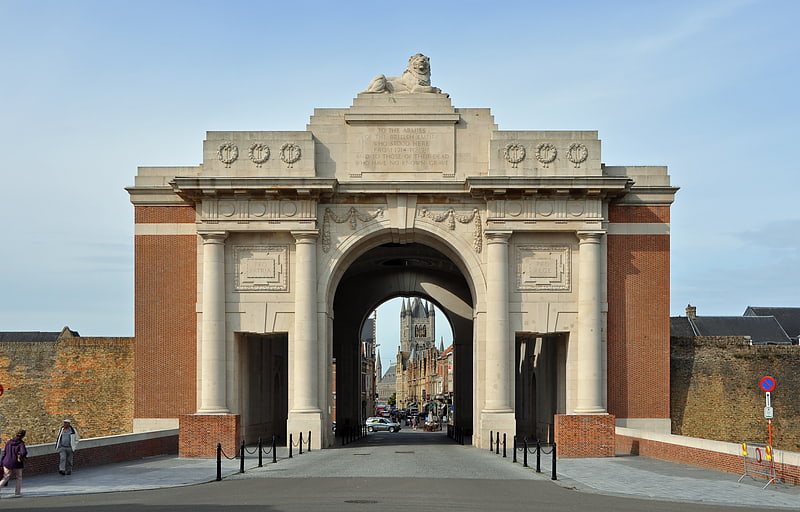
Also known as: Porte de Menin
War memorial in Ypres, Belgium. The Menin Gate Memorial to the Missing is a war memorial in Ypres, Belgium, dedicated to the British and Commonwealth soldiers who were killed in the Ypres Salient of World War I and whose graves are unknown. The memorial is located at the eastern exit of the town and marks the starting point for one of the main roads out of the town that led Allied soldiers to the front line. “Menin” is the traditional name of the gate in this location of Ypres' city walls because it leads to the town of Menen. Designed by Sir Reginald Blomfield and built by the Imperial War Graves Commission, the Menin Gate Memorial was unveiled on 24 July 1927.[2]
St Martin's Cathedral
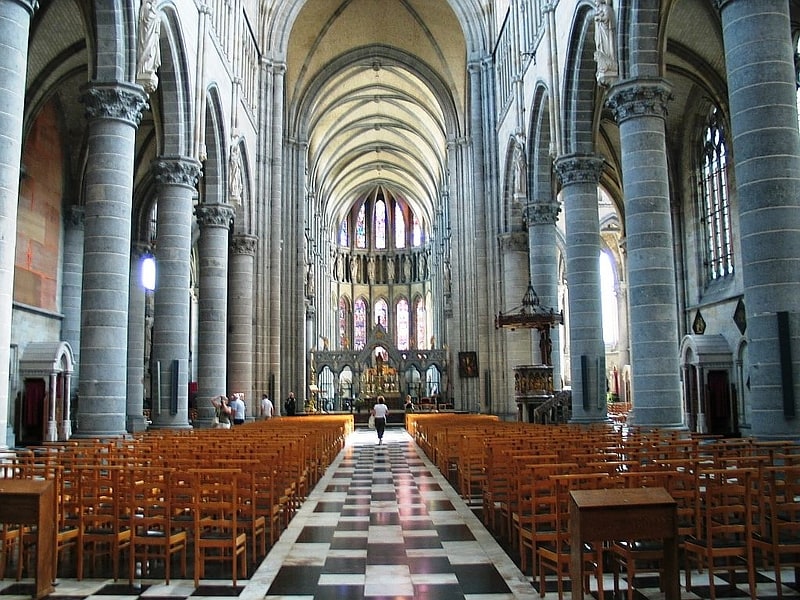
Also known as: Cathédrale Saint-Martin d'Ypres
Building in Ypres, Belgium. St Martin's Church, also called St Martin's Cathedral, is a church and former cathedral in the Belgian city of Ypres. It was a cathedral and the seat of the former diocese of Ypres from 1561 to 1801, and is still commonly referred to as such. At 102 metres tall, it is among the tallest buildings in Belgium.[3]
Address: 59 Vandenpeereboomplein, Ypres
Langemark German war cemetery
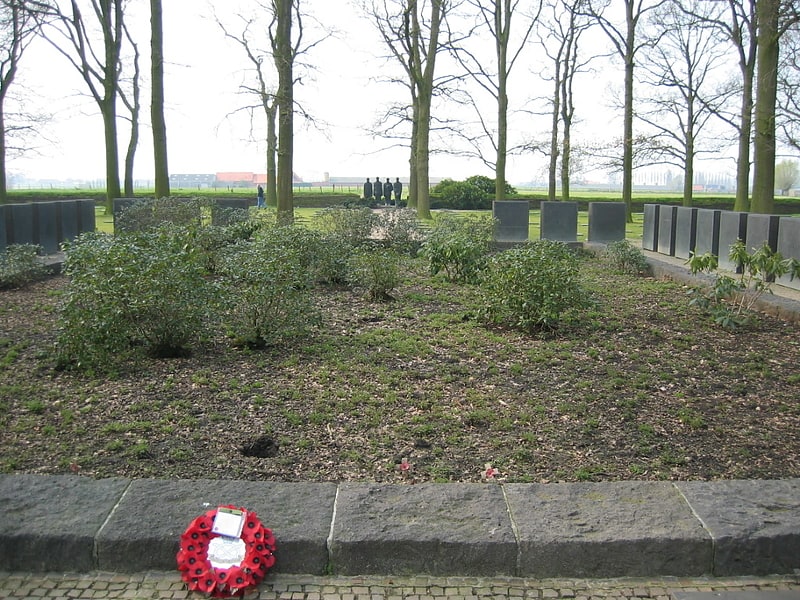
Also known as: Cimetière militaire allemand de Langemark
Cemetery. The German war cemetery of Langemark is near the village of Langemark, part of the municipality of Langemark-Poelkapelle, in the Belgian province of West Flanders. More than 44,000 soldiers are buried here. The village was the scene of the first gas attacks by the German army in the western front, marking the beginning of the Second Battle of Ypres in April 1915.
During the First Battle of Ypres (1914) in World War I, inexperienced German infantry suffered severe casualties when they made a futile frontal attack on allied positions near Langemark and were checked by experienced French infantry and British riflemen. Contrary to popular myth, only fifteen percent of the German soldiers involved in the Battle of Langemark were schoolboys and students. Legend has it that the German infantry sang the first stanza of what later (1919) became their national anthem "Deutschland, Deutschland über alles", as they charged.
The cemetery, which evolved from a small group of graves from 1915, has seen numerous changes and extensions. It was dedicated in 1932. Today, visitors find a mass grave near the entrance. This comrades' grave contains 24,917 servicemen, including the Ace Werner Voss. Between the oak trees, next to this mass grave, are another 10,143 soldiers (including 2 British soldiers killed in 1918). The 3,000 school students who were killed during the First Battle of Ypres are buried in a third part of the cemetery. At the front of the cemetery is a sculpture of four mourning figures by Professor Emil Krieger. The group was added in 1956, and is said to stand guard over the fallen. The cemetery is maintained by the German War Graves Commission, the Volksbund Deutsche Kriegsgräberfürsorge.
Otherwise, this cemetery has two Commonwealth burials.[4]
In Flanders Fields Museum
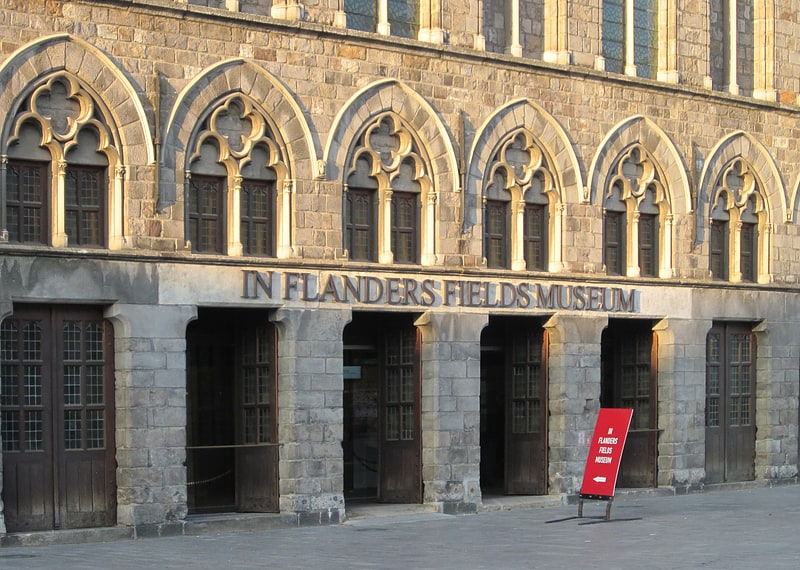
Displays on WWI and regular events. The In Flanders Fields Museum is a museum in Ypres, Belgium, dedicated to the study of the First World War. It occupies the second floor of the Cloth Hall on the market square in the city centre. The building was largely destroyed by artillery during the war, but was afterwards reconstructed. In 1998 the original Ypres Salient Memorial Museum was refurbished and renamed In Flanders Fields Museum after the famous poem by Canadian John McCrae. Following a period of closure, the museum reopened on 11 June 2012. The curator, Piet Chielens, is a World War I historian.
The museum does not set out to glorify war, but to suggest its futility, particularly as seen in the West Flanders front region in World War I.[5]
Address: Grote Markt 34, 8900 Ieper
Hill 60

Battle site in Ypres, Belgium. Hill 60 is a World War I battlefield memorial site and park in the Zwarteleen area of Zillebeke south of Ypres, Belgium. It is located about 4.6 kilometres from the centre of Ypres and directly on the railway line to Comines. Before the First World War the hill was known locally as Côte des Amants. The site comprises two areas of raised land separated by the railway line; the northern area was known by soldiers as Hill 60 while the southern part was known as The Caterpillar.[6]
Address: Zwarteleenstraat 36-40, 8902 Ypres
Saint George's Memorial Church
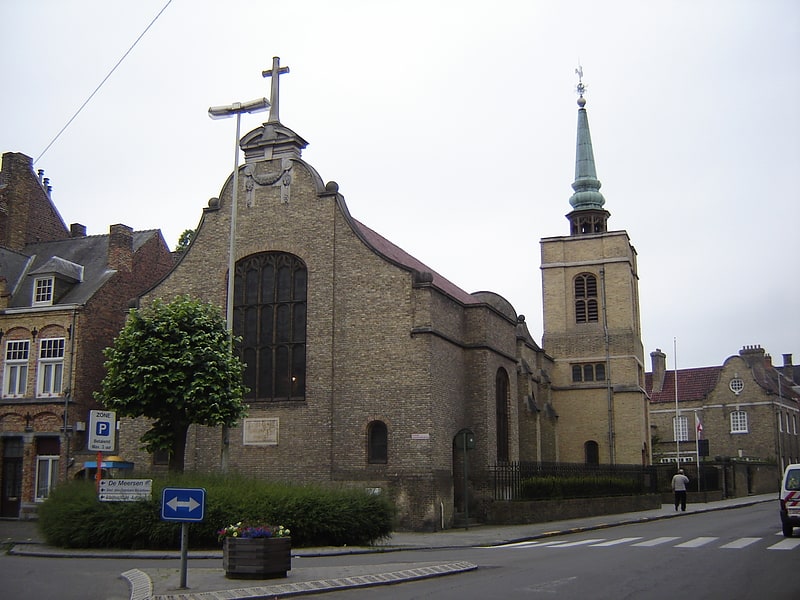
Also known as: Église-mémorial Saint-Georges d'Ypres
Anglican church in Ypres, Belgium. Saint George's Memorial Church, Ypres, Belgium, was built to commemorate over 500,000 British and Commonwealth troops, who had died in the three battles fought for the Ypres Salient, during World War I. It was completed in 1929.
The church was built following an appeal led by The Ypres League and its President Field Marshal Sir John French, Earl of Ypres, for a British memorial church to be built. Land was given by the town, and the foundation stone was laid by Field Marshal Lord Plumer on 24 July 1927. The church was consecrated by the Bishop of Fulham on 24 March 1929. The architect was Sir Reginald Blomfield whose work included the Menin Gate (1922) and other war memorials.
The church is part of the Diocese in Europe of the Church of England and is also a Belgian national monument. The church is open every day from 9:30 am until dusk (4 pm in winter).
The church has many plaques and memorials to regiments, associations and individuals.[7]
Address: Elverdingsestraat 1, 8900 Ieper
Essex Farm Cemetery
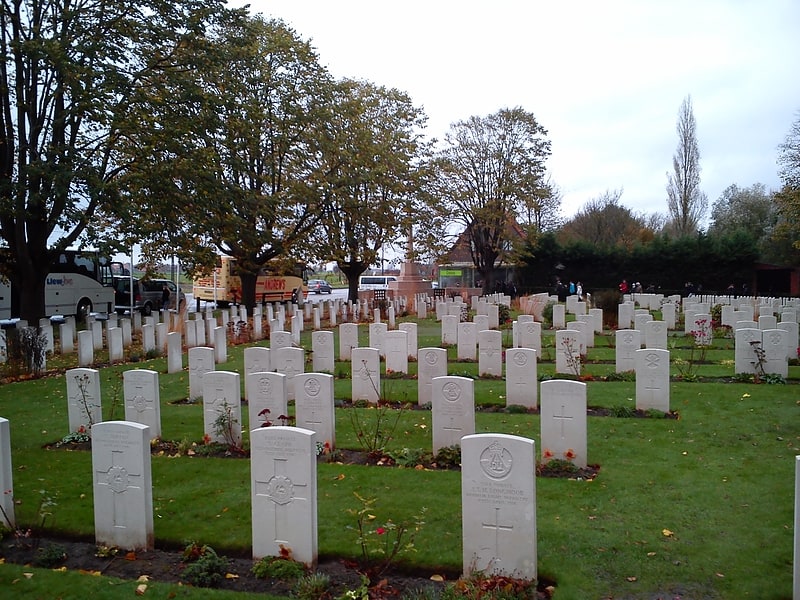
Burial ground. Essex Farm Cemetery is a World War I, Commonwealth War Graves Commission burial ground within the John McCrae Memorial Site near Ypres, Belgium. There are 1,204 dead commemorated, of which 104 are unidentified. The cemetery was designed by Sir Reginald Blomfield and has an area of 6,032 square metres.[8]
Address: east side of the N369 Ieper - Boezinge Rd, Ypres
Ramparts Cemetery

Burial ground. Ramparts Cemetery is a Commonwealth War Graves Commission burial ground for the dead of the First World War located in the Ypres Salient on the Western Front.
The cemetery grounds were assigned to the United Kingdom in perpetuity by King Albert I of Belgium in recognition of the sacrifices made by the British Empire in the defence and liberation of Belgium during the war.[9]
Ypres Reservoir Commonwealth War Graves Commission Cemetery

Burial ground. Ypres Reservoir Cemetery is a Commonwealth War Graves Commission burial ground for the dead of the First World War located in the Ypres Salient on the Western Front.
The cemetery grounds were assigned to the United Kingdom in perpetuity by King Albert I of Belgium in recognition of the sacrifices made by the British Empire in the defence and liberation of Belgium during the war.[10]
Address: 8900 Ypres, Ypres
Museum Godshuis Belle
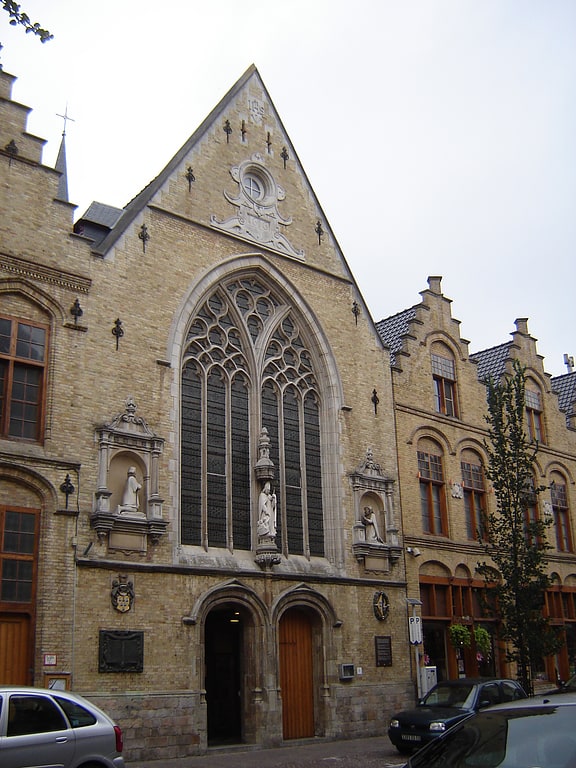
Museum in Ypres, Belgium. The Museum Godshuis Belle is a small museum in Ypres. Located in the chapel of an old almshouse, it houses the art collection of the Ypres Public Centre for Social Welfare.[11]
Address: Rijselstraat 38, 8900 Ieper